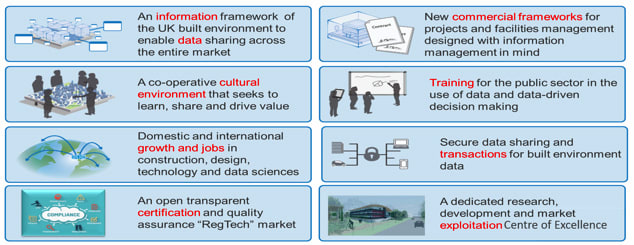At Digital Construction Week, David Philp set out the journey plan for the hugely ambitious Digital Built Britain. Here he talks through the plan in more detail – and explains how, in the future, suppliers could be paid based on what they have delivered and how an asset performs.
For those that attended Digital Construction Week (DCW) one of the golden threads of the two days was the presence of the Digital Built Britain (DBB) team who outlined the future of the government programme for digitisation of the built environment.
Level 2 BIM was never intended to be the final station and there was a longer-term trajectory towards Level 3. DBB is an ambitious programme which will help us plan new infrastructure and built assets more effectively, create (or more likely assemble) it at a lower cost, and operate and maintain it more efficiently.
The vision for DBB is to “provide a seamless transition from the achievements of Level 2 BIM and the Construction Strategy into an environment where technology as a system is second nature”. The aim? To help create a thriving UK digital economy for the built environment which will “encourage growth and competitiveness”. It will allow us to make better use of current and future infrastructure.
Below is a summary of what the DBB programme is set to deliver:

Helping resolve the productivity challenge
One of the central themes of my address at DCW was the UK productivity challenge and how it is constraining our economic output and living standards. With as much as a 20% gap between our digitisation of construction provides a real opportunity to increase productivity.
Measuring and monitoring data means we can measure “in service” performance. In the future, suppliers could be paid based on what they have delivered and how an asset performs. Performance outcomes will likely play a fundamental part of the procurement process improving UK productivity.
A commitment to making Level 2 BIM business as usual
The DBB programme has an ongoing commitment to embedding Level 2 BIM in the public sector through a collaborative approach and the work of the DBB Level 2 BIM Working Group.
The group has the primary goal of making Level 2 business as usual, and is supporting government departments and wider public-sector clients to develop a common approach to BIM Level 2 implementation.
Through benefits realisation management, measurement and reporting, as well as case studies, the group is building a better understanding of the benefits of BIM Level 2. The aim is to gain and increase commitment from departments’ senior leaders.
Yet, while cementing Level 2 as “business as usual” is a key concept of the DBB strategy, we must all make Level 1 BIM the central plank to build from. We should also recognise the tireless work of the BIM communities, such as the UK BIM Alliance.
Level 2C (Convergence)
Ensuring data value can be maximised through the whole-life use requires those that are concerned with building and operating assets and those concerned with data measurement and the smart city community to work together.
It also requires us to think about our current delivery model. Advanced manufacturing, using innovative technology to improve products and processes is essential. We have to apply offsite thinking to find smart ways to standardise and optimise.
The Level 2 Convergence programme builds the bridge and shows data pathways from the existing Level 2 world of construction connecting to the smart city world of services, consumers and the citizen (and vice versa, where you can define the outcomes needed by city administration and citizens and determine the built assets to achieve these).
This will prove how built assets will impact services and the citizen, and provide feedback to improve the planning and design process. It incorporates other plentiful information sources that exist in our smart cities using IoT and other methods to securely capture data.
Where next? Beyond Level 2
With all the basic Level 2 BIM artefacts (other than Part 6 and 7) now in place and departments on a BIM journey with ever growing maturity and capacity, the next transition is to the longer Level 3 programme and increased functionality.
The Level 3 programme is a cross-sectoral digital transformation programme for the full lifecycle of the built environment to increase productivity, improve economic and social outcomes. Level 3 is not purely BIM, rather it is part of a wider building environment digitisation.
It will create the framework, standards, guidance, deliver pilots and outline the industry change needed for how information about all assets in the built (and interface to the natural) environment are planned and used to perform their functional service and provide socio-economic benefit –creating the right things with better outcomes.
The BIM level 2 mandate in April 2016 signified the start rather than the end of the journey. It has paved the way for our next stage of delivery.
David Philp FCIOB is a member of the Digital Built Britain team and a trustee of the CIOB
While cementing Level 2 as ‘business as usual’ is a key concept of the DBB strategy, we must all make Level 1 BIM the central plank to build from. We should also recognise the tireless work of the BIM communities, such as the UK BIM Alliance.– David Philp











